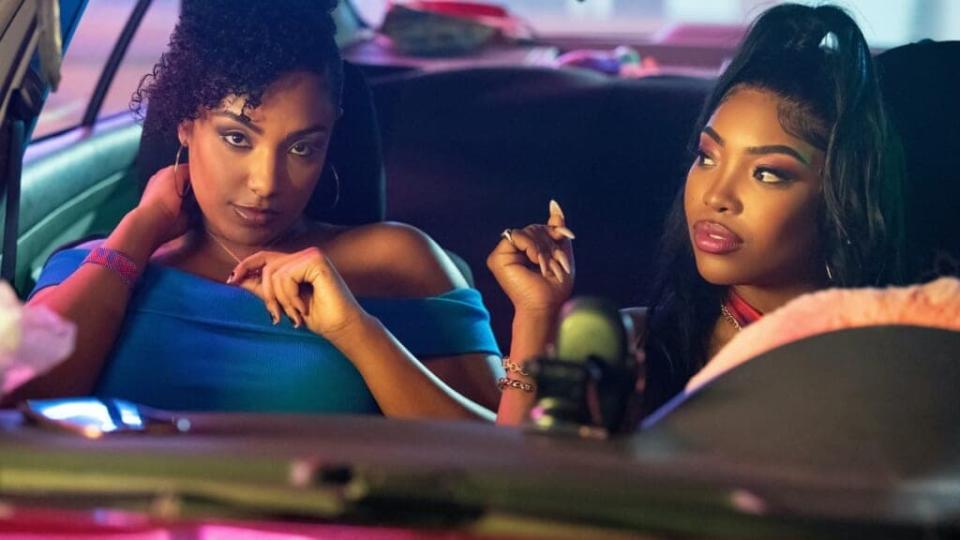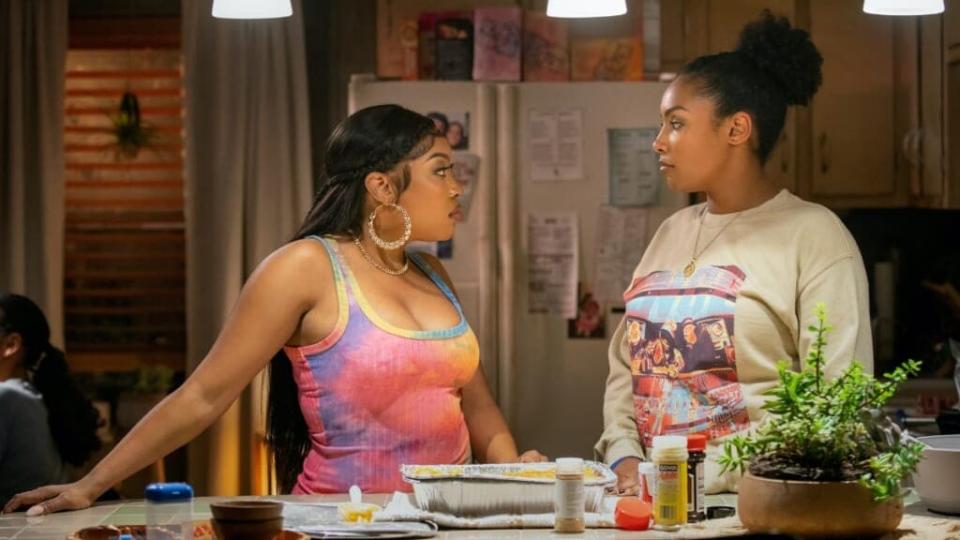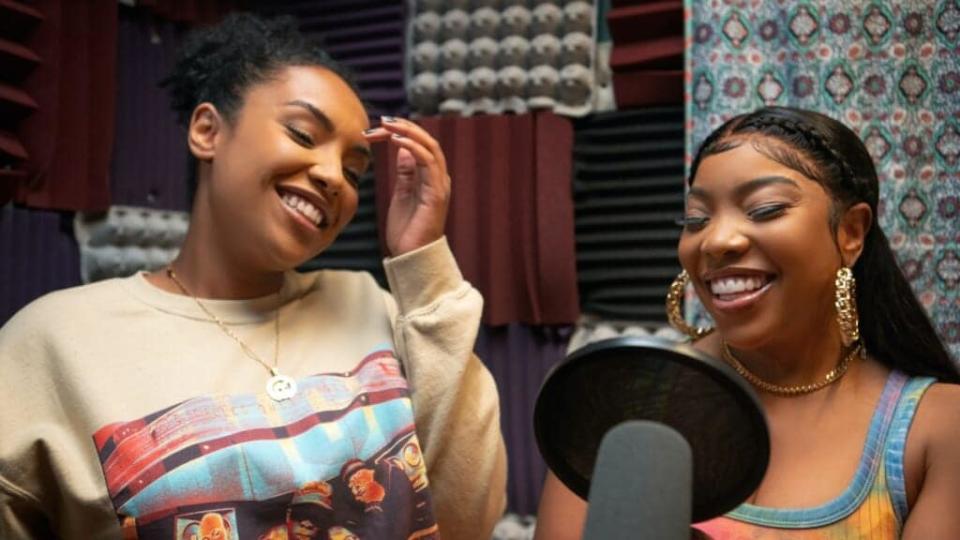How ‘Rap Sh!t’ Celebrates and Speaks to the Current ‘Female Rap Renaissance’
- Oops!Something went wrong.Please try again later.
- Oops!Something went wrong.Please try again later.
It was the height of quarantine, and Issa Rae wanted — in Bay Area rapper Saweetie’s proverbial words — “Something fun, something for the summertime. Something for the girls to get ready and party to.”
The final season of her seminal hit series “Insecure” was in production, and HBO Max had approached the Emmy-nominated co-creator and star’s team to ask what her next show was going to be about. The multi-hyphenate had long been wanting to tell a story about female rappers and eventually sent in the one-pager for what would become “Rap Sh!t” to Montrel McKay, her production company Hoorae’s film and television president, and her manager Jonathan Berry. They had no notes.
“Anything you see about Issa is what she believes in,” McKay told TheWrap about the show’s “straightforward” development process at the streamer. “If her name is on it, it’s things she’s been talking about for years. It’s something that’s been an idea of hers forever.”
“Rap Sh!t” — created and executive produced by Rae — unfolds against a bustling Miami setting, telling the story of two estranged 20-somethings, Shawna (Aida Osman, who also serves as a writer on the series) and Mia (Grammy-winning songwriter and rapper KaMillion), who after a chance reconnection decide to form a rap duo.
When we meet the pair, both women are at their limit: Hotel concierge worker Shawna is on the precipice of a professional existential crisis, tired of not being recognized for her thought-provoking lyricism online, and Mia is burnt-out from juggling three jobs (office manager, stripper and makeup artist) as a single mother. But despite their struggles toward figuring out who they are and what they want, Rae was deliberate in crafting a “fun show that I wanted to watch, a world that I wanted to live in.”

“I really wanted to create a show that people would have a good time too,” Rae told TheWrap. “I wanted to make a show that felt like my favorite female rap banger and this show, to me, should feel like riding in the car with your girlfriends, going on an adventure, listening to the best playlist.”
Insofar as Shawna and Mia are singular characters, the series also takes inspiration from prominent women rappers working today like Megan Thee Stallion and explores how the current musical landscape is influenced by the dominance of social media and streaming platforms. While Shawna’s journey embodies elements of Chicago rapper Noname’s rise and Mia’s trajectory emulates Cardi B’s origin story, “Rap Sh!t” takes its primary features (and namesake) from the Miami-hailing rap group City Girls, comprising Yung Miami and JT, who serve as executive producers on the show and who gave Rae their blessing to move forward.
For showrunner Syreeta Singleton, who previously worked as the executive story editor on the final season of “Insecure,” the main pair in “Rap Sh!t” are unique to the television landscape, but also speak to the broader nature of — as Mia puts it on the show — the “bad bitch renaissance” occurring in rap music.
“We wanted it to feel current, and we’re in the midst of watching this female rap renaissance. So it’s like being in the midst of it, and writing about it at the same time — it was really exciting. And it made the room fun as a showrunner too,” Singleton told TheWrap, adding that the writers’ room would research by watching music videos, reading blogs and discussing trending topics.
As both Singleton and Rae describe it, the relationship between Shawna and Mia is the show’s grounding force, an “odd couple” pairing that works because of the actresses’ distinct chemistry.
“The idea of estranged friends reconnecting really spoke to me specifically because I’ve experienced that in my own life recently, and there is something really unique about experiencing someone who you have a history with with fresh eyes because of a gap, a gap in time or experience,” Rae said.
It’s a bond that KaMillion values as vital to depict on-screen, since “we should be seeing more young Black women fellowshipping and getting money and learning together.”
KaMillion, who is a Jacksonville native, went through the audition process with Osman, who she says is “my twin … same Zodiac sign [Cancer]” and the “same person in different worlds.” She added, “I f—ed with her the first time I seen her, like we just vibed. She’s a dope artist, she’s a dope writer and she’s just a cool girl.”
One of the main tensions in “Rap Sh!t” is Shawna and Mia’s differing outlooks on how female rappers should hone and display their craft. The former is adamant about ensuring listeners tune in solely because of her skill, and she dresses down and dons a mask to avoid making music for the male gaze. Mia doesn’t see it that way: Women can own their sexuality, be empowered to show off their bodies and still command a track.
“While the hip-hop industry, the rap industry is still male-dominated, women are having such an important moment. But even still, you had a prominent producer say that all women right now are talking about is their pussies. And so there’s still this point of view that men get to dictate what women rap about,” Rae said of wanting to portray this dichotomy in the series. “And then there’s the other side of it, where it’s like, there are women who want to be taken seriously as lyrical rappers and conscious rappers and who just feel like they don’t have this same space and aren’t appreciated the same.” (Rae is likely referring to So So Def Recordings founder and owner Jermaine Dupri, who made such comments in the summer of 2019 and was called out by Cardi B for doing so.)
As “Rap Sh!t” explores this juxtaposition, its beauty is in how Mia’s support allows Shawna to explore her confidence, and how, consequently, she’s able to help the former believe that making music professionally can be a viable career path.
“Shawna is so specific and different,” Singleton said. “She’s a college dropout, she went to Spelman. She has this big moral code and like this, ‘I have to be saying something’ and then it’s just like, how do you see that person then loosen up, and how do they collaborate with someone like Mia?”
Also Read:
‘Rap Sh!t’ Review: Issa Rae Seizes on a Timely Pop Culture Moment in New HBO Max Series
Singleton added that she’s “passionate” about authentically showcasing a character like Mia on TV and “showing that Black girls from the hood are creative and smart” and can thrive when there’s a structural support system around them to buoy their dreams.
“When we talk about having a Black girl from the hood, who’s hustling, who has three different jobs … chasing dreams can feel like a luxury when you don’t have anything,” Singleton said. “Sometimes it really takes someone outside of you — whether that be a teacher, a mentor, or even in Mia’s case, Shawna — who believes in you, who tells you you can do it and then also kind of holds your hand and shows you how.”
For KaMillion, it was easy to step into Mia’s red bottoms. The actress said she drew from her past experiences to tap into the character, in addition to “channeling my inner Taraji P. Henson.”
“When you’re going through situations and you don’t know how they’re gonna end up and then you see a script that is kind of mirroring your life, and you get a chance to bring a certain satire to real life — like sh– that wasn’t funny at the time when you was going through it, but now you can look back and laugh at it and then put everything that you went through and put yourself back in that space,” she said.
To the extent that “Rap Sh!t” is a serialized depiction of some of today’s anthemic Hot Girl bangers, its core theme, for Singleton, is the continual process of reinvention, taking a “really layered approach to who we are, and all of the intricacies of that.”
“Who we are, and who we are authentically — this idea of authenticity, what is it? How to attain it? How to represent it? And constantly kind of checking yourself in that way, I feel like we see that with all of our characters,” she said.
The search for authenticity moves beyond thematic considerations — it’s embedded into the very storytelling DNA of the show. When it came time to set the city for “Rap Sh!t,” Rae knew Los Angeles had gotten its love letter via “Insecure” and that a city like Houston was serving as the basis for another show of hers currently in development (HBO’s “Him or Her”). Miami seemed like the obvious choice, for its fun and brash environment. As a result, the show spotlights Miami Black-owned businesses, involves native musicians and leans on writers and consultants who grew up in the area, like staff writer and comic Kid Fury.

As a music-centered series, Rae said her label Raedio was instrumental in overseeing music supervision and creating original songs for the show. In addition to crafting new tracks for Shawna and Mia (watch out for “Seduce and Scheme”), the series set up a “Miami music camp,” where local and big-name artists were invited to create music specifically for the show.
But, as “Rap Sh!t” expertly lays out, “You can’t talk about the music industry and have success without perfecting social media and your persona online,” Rae explained. The series, in part, unfolds through snapshots and platforms that are like second-nature to its target audience; viewers see pivotal moments take place through the lens of Instagram lives, phone recordings and TikTok screens.
Because of this multilayered formatting and the speed of internet trends, the innovative cinematography took a “different level of research” for everyone involved on the show. Even laying out Instagram’s format was a challenge, given how frequently the app updates its features. Most importantly, the show highlights social media as a tool for connecting people, as the main duo is reacquainted by hesitant Instagram DMs.
“In addition to it feeling like a really cool and different way to tell a story, it also informs so much of who our characters were,” Singleton said. “As viewers, [we] spend so much time on … social media. We’re watching things on it. We’re learning new information. We get our news on it, we discover music from it. Our favorite artists, we’re tracking them, we’re tracking what they do. It just felt really natural.”
Also Read:
‘Insecure’ Actress Christina Elmore Joins HBO Max Series ‘Girls on the Bus’
But it also took deft to ensure the series’ distinctive format didn’t overtake the storytelling: “We were visually pulling a new kind of story and trying things out and it still had to feel cohesive,” Rae — who was also inspired by her own background of coming up through YouTube and social media — said. “So there was a lot of trial and error and revamping and retooling just to make sure that while we were trying something new that it wouldn’t overshadow the most important thing, which is the story of these two girls.”
In a full-circle moment, KaMillion, who credits her rise to perfecting social media usage, said she first heard of the show on Instagram, through a Shade Room post two years ago. “I hear some people say, ‘Oh, I don’t be on social media like that. I don’t be doing all that.’ It’s like, ‘Girl, you must not get no money.’ Because social media is everything,” she joked.
McKay, who executive produces for Hoorae, said the sophomore pressure to make a standout show was overwhelming at times, especially since the series was being put together by a newly minted showrunner and newcomer actors, directors and DPs.
“It was scary because when … your first show out the gate is one of the most important shows in the canon of Black TV, how do you follow that up, right?” he said.
But that didn’t deter Rae. “Issa’s a risk taker” and her goal is to uplift other creatives who are trying to get their break, as well as tell the stories of a wide breadth of Black people and do so “organically,” McKay said.

“I think the brilliance of Issa’s that she’s an incredible producer as well, so she’s always aerating and tweaking things,” McKay said, adding, “I’m not gonna lie and say that there weren’t a lot of uncomfortable conversations that we had. Once we got to a place of just making our litmus test — whether or not we believed in the talent — and we said, ‘We’re not gonna let fear or concern about how audiences are going to react to something dictate the decisions that we make, and we’re going to just stick to our principles.’”
Shedding the pressure surrounding the hotly anticipated series is what allows “Rap Sh!t” to go back to the basics amid a backdrop of chaotic molly-fueled nightlife adventures and audaciously disrespectful hotel guests. Ultimately, it’s a story of two young women rediscovering music, each other and themselves.
“I approached this like a coming-of-age story about two young friends who grew up on social media, and this kind of identity of who you are, who you present yourself to be and kind of knowing the difference is something that they’re kind of still figuring out and what drives and motivates so much of what they do,” Singleton said.
With coming-of-age comes chasing after what you want, no matter how out of reach that seems.
“Like Nike, just do it,” KaMillion said. “I mean, a lot of people may deter you from your dreams because they’re afraid that you’ll end up making it for real, and they always reflect their shoulda-woulda-coulda upon your life. But, man, just do that s—. You don’t know where it’s gonna get you.”
For Shawna and Mia, the answer is still up in the air, but it’s clear that the pair are closer to self-fulfillment when they’re together, drunkenly freestyling in a car, having fun and being unafraid to embody their unapologetic selves.
As KaMillion simply puts it, “It’s nothing like it on TV right now.”
Also Read:
Michelle Obama Announces a Follow-Up to ‘Becoming': Her Second Memoir, ‘The Light We Carry’

